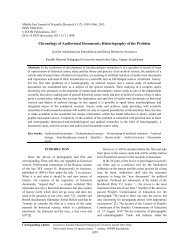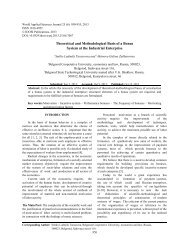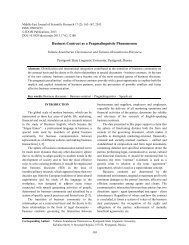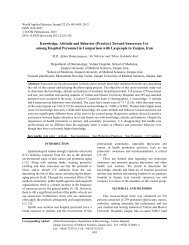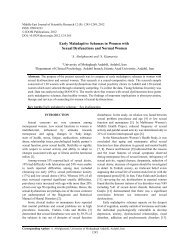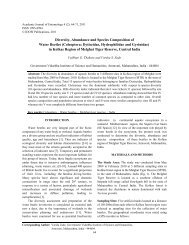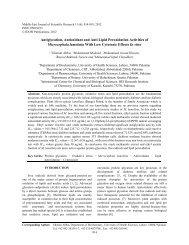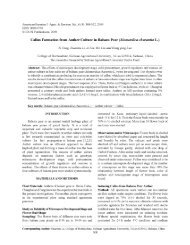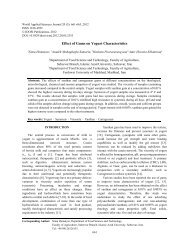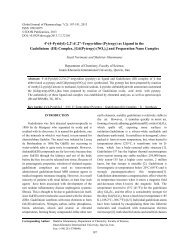Antimicrobial Activity of Some Important Medicinal Plant ... - Idosi.org
Antimicrobial Activity of Some Important Medicinal Plant ... - Idosi.org
Antimicrobial Activity of Some Important Medicinal Plant ... - Idosi.org
Create successful ePaper yourself
Turn your PDF publications into a flip-book with our unique Google optimized e-Paper software.
World J. Agric. Sci., 4 (S): 839-843, 2008<br />
Bark extract <strong>of</strong> Tinospora cordifolia showed varied in the exploitation <strong>of</strong> antifungal or antibacterial property <strong>of</strong><br />
zone <strong>of</strong> inhibition from 10-14 mm against all the tested<br />
bacteria. Root and leaf extract <strong>of</strong> Withania somifera<br />
showed almost similar antibacterial activity against all the<br />
tested bacteria. Leaf extract <strong>of</strong> Ziziphus mauritiana<br />
showed highest activity against E. coli and X. a. pv.<br />
malvacearum (18 mm) lowest activity were observed in<br />
S. aureus, P. fluorescens and B. subtilis around 15 mm<br />
zone <strong>of</strong> inhibition. Bark extract <strong>of</strong> this plant showed<br />
significant activity against S. aureus followed by E. coli,<br />
X. a. pv. malvacearum and the minimum activity were<br />
observed in B. subtilis and P. fluorescens. Among<br />
the five plants viz., Acacia nilotica, Sida cordifolia<br />
Tinospora cordifolia, Withania somnifera and<br />
Ziziphus mauritian, leaf and bark extract showed<br />
significant antibacterial activity against the test<br />
pathogens. Leaf extract showed significant activity when<br />
compared with the bark/root extract <strong>of</strong> all the test plant<br />
extract. Bark extract <strong>of</strong> all the five plant extracts was<br />
almost similar or higher activity when compared with the<br />
streptomycin sulphate.<br />
Antifungal activity <strong>of</strong> five plant leaf extract showed<br />
significant activity when compared with the bark/root<br />
extract. Acacia nilotica bark and leaf extract showed<br />
antifungal activity against Aspergillus flavus (12 mm)<br />
followed by leaf extract <strong>of</strong> Zizphus mauritian (11 mm).<br />
Tinospora cordifolia and Withania somnifera bark extract<br />
recorded better activity against Dreschlera turcica<br />
followed by leaf extract <strong>of</strong> Tinospora cordifolia and<br />
Withania somnifera. Fusarium verticillioides recorded<br />
susceptibility for all the five plant leaf and bark /root<br />
extract. All the five plants viz., Acacia nilotica,<br />
Sida cordifolia Tinospora cordifolia, Withania somnifera<br />
and Ziziphus mauritian showed less antifungal activity<br />
when compared with Nystatin.<br />
DISCUSSION<br />
<strong>Plant</strong>s are important source <strong>of</strong> potentially useful<br />
structures for the development <strong>of</strong> new chemotherapeutic<br />
agents. The first step towards this goal is the in vitro<br />
antibacterial activity assay [12]. Many reports are<br />
available on the antiviral, antibacterial, antifungal,<br />
anthelmintic, antimolluscal and anti-inflammatory<br />
properties <strong>of</strong> plants [13,14,15,16,17,18,19]. <strong>Some</strong> <strong>of</strong> these<br />
observations have helped in identifying the active<br />
principle responsible for such activities and in the<br />
developing drugs for the therapeutic use in human<br />
beings. However, not many reports are available on the<br />
842<br />
plants for developing commercial formulations for<br />
applications in crop protection.<br />
In the present study, the methanol leaf, root/bark<br />
extracts <strong>of</strong> Acacia nilotica, Sida cordifolia Tinospora<br />
cordifolia, Withania somnifera and Ziziphus mauritian<br />
showed the activity against B. subtilis, E. coli,<br />
P. fluorescens, S. aureus, X. axonopodis pv.<br />
malvacearum, A. flavus, D. turcica and F. verticillioides<br />
and <strong>Plant</strong> based products have been effectively proven<br />
for their utilization as source for antimicrobial<br />
compounds. For instance, methanol extracts <strong>of</strong> A. ferox<br />
and W. somnifera exhibited inhibitory activity against all<br />
the strains <strong>of</strong> N. gonorrhoea while, only the methanol<br />
extract <strong>of</strong> W. somnifera was effective against C. albicans<br />
[20]. The antibacterial activity <strong>of</strong> aqueous, different<br />
solvent extracts and isolated constituents <strong>of</strong> leaves <strong>of</strong><br />
Acacia nilotica were evaluated by the cup diffusion<br />
method against three phytopathogenic Xanthomonas<br />
pathovars viz., Xanthomonas axonopodis pv.<br />
phasedi, X. axonopodis pv. malvacearum and<br />
X. axonopodis pv. vesicatoria. Methanol extract was<br />
subsequently fractioned and monitored by bioassay<br />
leading to the isolation <strong>of</strong> active fraction by further<br />
phytochemical analysis [21]. Futher, monomeric<br />
glycoprotein namely, WSG (Withania somnifera<br />
glycoprotein) isolated from W. somnifera root tubers<br />
revealed (protease inhibitor) antimicrobial activity against<br />
few bacterial and phytopathogenic fungi [22]. WSG also<br />
provided a fungi stastic effect by inhibiting spore<br />
germination and hyphal growth in the tested fungi.<br />
On the contrary, [23] observed that water,<br />
methanol and acetone extracts did not have activity on<br />
S. marcescens, a gram-negative bacterium. Apart from<br />
antimicrobial activities, these plant extracts are also<br />
exploited for therapeutic purpose to cure several<br />
disorders. Methanol extract <strong>of</strong> the root <strong>of</strong> Z. mauritiana<br />
was found to inhibit the severity <strong>of</strong> diarrhoea induced by<br />
castor oil. It is speculated that the extract was able to<br />
inhibit electrolyte permeability in the intestine due to<br />
castor oil and or through the inhibition <strong>of</strong> prostaglandins<br />
release [24].<br />
The results <strong>of</strong> present investigation clearly indicate<br />
that the antibacterial and antifungal activity vary with the<br />
species <strong>of</strong> the plants and plant material used. Thus, the<br />
study ascertains the value <strong>of</strong> plants used in ayurveda,<br />
which could be <strong>of</strong> considerable interest to the<br />
development <strong>of</strong> new drugs.



